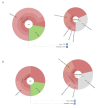Combining Analysis of DNA in a Crude Virion Extraction with the Analysis of RNA from Infected Leaves to Discover New Virus Genomes
- PMID: 30102276
- PMCID: PMC6126564
- DOI: 10.3791/57855
Combining Analysis of DNA in a Crude Virion Extraction with the Analysis of RNA from Infected Leaves to Discover New Virus Genomes
Abstract
This metagenome approach is used to identify plant viruses with circular DNA genomes and their transcripts. Often plant DNA viruses that occur in low titers in their host or cannot be mechanically inoculated to another host are difficult to propagate to achieve a greater titer of infectious material. Infected leaves are ground in a mild buffer with optimal pH and ionic composition recommended for purifying most bacilliform Para retroviruses. Urea is used to break up inclusion bodies that trap virions and to dissolve cellular components. Differential centrifugation provides further separation of virions from plant contaminants. Then proteinase K treatment removes the capsids. Then the viral DNA is concentrated and used for next-generation sequencing (NGS). The NGS data are used to assemble contigs which are submitted to NCBI-BLASTn to identify a subset of virus sequences in the generated dataset. In a parallel pipeline, RNA is isolated from infected leaves using a standard column-based RNA extraction method. Then ribosome depletion is carried out to enrich for a subset of mRNA and virus transcripts. Assembled sequences derived from RNA sequencing (RNA-seq) were submitted to NCBI-BLASTn to identify a subset of virus sequences in this dataset. In our study, we identified two related full-length badnavirus genomes in the two datasets. This method is preferred to another common approach which extracts the aggregate population of small RNA sequences to reconstitute plant virus genomic sequences. This latter metagenomic pipeline recovers virus related sequences that are retro-transcribing elements inserted into the plant genome. This is coupled to biochemical or molecular assays to further discern the actively infectious agents. The approach documented in this study, recovers sequences representative of replicating viruses that likely indicate active virus infection.
Similar articles
-
Comparison of Next-Generation Sequencing Versus Biological Indexing for the Optimal Detection of Viral Pathogens in Grapevine.Phytopathology. 2015 Jun;105(6):758-63. doi: 10.1094/PHYTO-06-14-0165-R. Epub 2015 May 29. Phytopathology. 2015. PMID: 25689518
-
k-mer-Based Metagenomics Tools Provide a Fast and Sensitive Approach for the Detection of Viral Contaminants in Biopharmaceutical and Vaccine Manufacturing Applications Using Next-Generation Sequencing.mSphere. 2021 Apr 21;6(2):e01336-20. doi: 10.1128/mSphere.01336-20. mSphere. 2021. PMID: 33883263 Free PMC article.
-
V-GAP: Viral genome assembly pipeline.Gene. 2016 Feb 1;576(2 Pt 1):676-80. doi: 10.1016/j.gene.2015.10.029. Epub 2015 Oct 22. Gene. 2016. PMID: 26475935
-
[The great virus comeback].Biol Aujourdhui. 2013;207(3):153-68. doi: 10.1051/jbio/2013018. Epub 2013 Dec 13. Biol Aujourdhui. 2013. PMID: 24330969 Review. French.
-
From deep sequencing to viral tagging: recent advances in viral metagenomics.Bioessays. 2013 May;35(5):436-42. doi: 10.1002/bies.201200174. Epub 2013 Mar 1. Bioessays. 2013. PMID: 23450659 Review.
References
-
- Dijkstra J, Jager CP. Practical Plant Virology : Protocols and Exercises. Berlin Heidelberg: Springer-Verlag; 1998. 1 edn.
-
- Roossinck MJ. Plant virus metagenomics: biodiversity and ecology. Annu Rev Genet. 2012;46:359–369. - PubMed
-
- Melcher U, et al. Evidence for novel viruses by analysis of nucleic acids in virus-like particle fractions from Ambrosia psilostachya. J Virol Methods. 2008;152(1-2):49–55. - PubMed
-
- Stobbe AH, Schneider WL, Hoyt PR, Melcher U. Screening metagenomic data for viruses using the e-probe diagnostic nucleic Acid assay. Phytopathology. 2014;104(10):1125–1129. - PubMed
Publication types
MeSH terms
Substances
Grants and funding
LinkOut - more resources
Full Text Sources
Other Literature Sources




